
|   |

|   |
The dance between silence and sound- Eshna Benegale-mail: eshna25@gmail.com Photos courtesy: Jagriti Theatre June 25, 2025 When dancers are left to create by themselves, they tend to choose silence - was one of my first thoughts as the lights closed on the Parabola of Dance, 2025. The festival, which is in its fifth year, is a space curated by Aditi Mangaldas Dance Company and The Drishtikon Dance Foundation as a part of The Legacy Project. It aims to give dancers the opportunity to workshop and share the creative process behind their productions. This year's show on June 7th, had a lineup of three exquisite talents including Bharatanatyam dancer Kavya Ganesh, contemporary dancer Snigdha Prabhakar and Kathak dancer Sanjukta Wagh. Each came to the stage with varying levels of expertise, influences and stories to tell and yet they were bound by a common thread - silence. 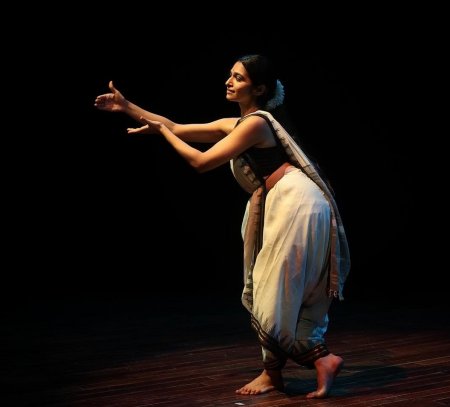 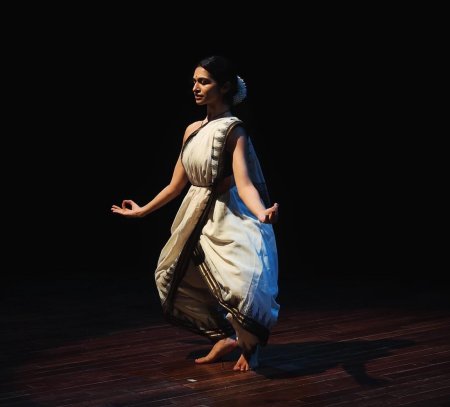 Kavya Ganesh Kavya Ganesh opened with a single image; her body turned to the side, leg lifted with her hand on her foot as she turned her head to look at something behind her - this was Shakuntala. Raja Ravi Varma's muse in his famous painting Shakuntala looking for Dushyanta captures the heroine as she looks for her lover while removing a thorn from her foot. This imagery is not uncommon in the classical canon where the thorn often represents the struggles a female character might go through to reach her lover. In Kavya Ganesh's Forever Interim, the thorn in Shakuntala's life was her identity. The work played with a line from Arundhati Subramaniam's Eight Poems for Shakuntala which read "just another mixed up kid, daughter of a sage and celestial sex worker." Ganesh explored the conflict in the line by highlighting the dichotomy between sensuality and austerity, between the work of the body and the work of the soul, between the prejudices these two professions inhabit. "She is just a messed up kid," was the hook for Ganesh's work - simple and relatable. Having seen a few of her explorations before, her ability to draw these simple yet evocative messages through epic pieces of literature is remarkable. Kavya's execution was a testament to not just her dancing, which is sharp and precise, but her nuanced acting which holds and stills you. This was the debut of Forever Interim and the first iteration of the work. It had several successes. For one I thought the emotional arc that Ganesh was able to draw had great pace and was very convincing. It also had several opportunities for audience interpretation. The silences built into the piece gave space for that especially in the music. The work featured pieces from HOME, an album by Sushma Soma and Aditya Prakash. The silence in her piece, which often occurred between notes of the soundtrack, allowed the audience space to ponder and ruminate their own interpretations of Shakuntala's conflict. What are the conflicts within us? What are the grey areas we inhabit? How do we navigate these somewhat messy, confusing parts of ourselves? 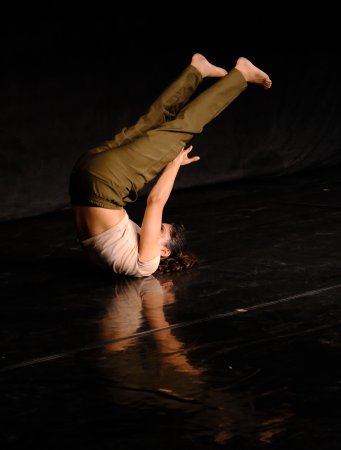 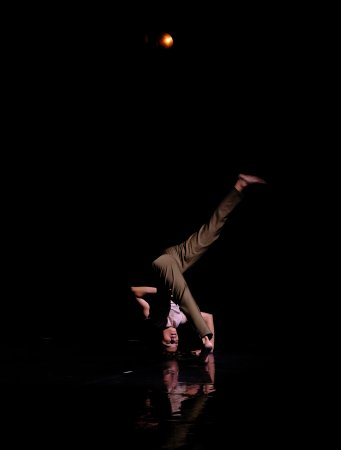 Snigdha Prabhakar "All Indians are my brothers and sisters," Snigdha Prabhakar declared as she stood in one corner of the stage. This pledge, without which a school assembly or sports day would not begin, became Prabhakar's peg in her work Relax Into Your Being. The bit showcased during the Parabola of Dance was a short segment from the full work. Prabhakar combined her strengths into this one piece; spoken word, B-boying, dance and most importantly, conviction. The piece sought to examine personal rebellion in a world of oppression. In her presentation that day she chose nationalism as her central theme and spoke about it through the familiar image of a school's sports day. Repetition became an essential tool in Relax Into Your Being. By repeating the pledge we are so used to, she made us hear it differently every time. She followed it up with a monologue of her own thoughts which questioned whether the values in the pledge, we can all deliver verbatim, actually carries through to our daily interactions. Her incorporation of B-Boying was first and foremost extremely impressive and second perfectly encapsulated the idea of freeing the body - yet another thematic element in the piece. Watching a woman on stage contort her body, showcase her strength through gravity defying movements is refreshing especially when wedged between two classical dance pieces which are often far more grounded - the differences really made you think. Having said that, it is important to remember that Prabhakar is a trained Bharatanatyam dancer too, yet another variable in the mix! At one point Prabhakar sat on her haunches, face in her hands and stared at the audience as she rocked back and forth in silence. The silence then is deafening. It is as if she wanted to say: I have said my piece, what's your take? What are you doing about the hatred sprouting in the world? In your minds and hearts? Are you conscious of it? With the growing intolerance in the country, Prabhakar's piece offered a brave insight into an increasingly polarised discussion about patriotism, nationality, and the individual in the nation. 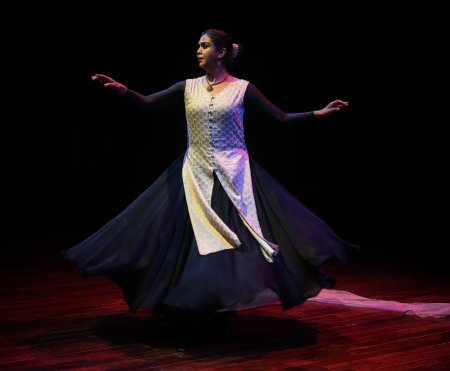 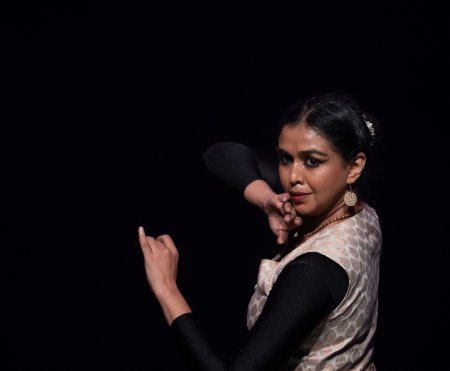 Sanjukta Wagh Music is often the crutch on which dance rests. Silence frees it. But a dancer making music herself brings the dance alive. Sanjukta Wagh's Jhulon: swinging between life and death explored the poem Jhulon by Rabindranath Tagore. The image Tagore paints in his poem is that of a swing which oscillates between life and death. Along with him on this journey is his ocean of consciousness which he calls his poraan vadhu or bride. The two sit side by side and contemplate the inevitability of death and the joy of life as they beckon "De dol dol, de dol dol," swing and swing. Wagh entered the stage holding a rain maker, she wielded it like a boat paddle - the image she painted reminded one of the boatman of death that carries souls to the underworld. Her choice of blue as the light that illuminated the image created an atmosphere of mystery which was enriched by the unusual sound of the bells she wore on her ankle (lavani bells she tells us later.) Through the rainmaker, her bells, and later on, a guitar solo and her padhant or recitation of rhythmic compositions, Wagh created a soundscape on which her dance painted freely. The pace of the piece came alive when we heard Rabindranath Tagore's voice reciting the poem. What stood out to me as a Kathak dancer myself was the structure in the piece. She entered first as the poet and second as his ocean of consciousness, the poraan vadhu. Wagh's bride was as mysterious as she was contemplative. The vibe was that of a woman that has the potential to come unchained. Oftentimes structure can restrict a piece. While it creates a definitive story it might limit flow and pace. However, Wagh maintained the flow by leaving sections of the work open to improvisation, she mentioned in the post-show discussion. The mood of Jhulon was deliciously eerie and mysterious. That was a result of Wagh's use of props like the rainmaker, her ghungroos or ankle bells and the dupatta she carried while depicting the ocean of consciousness. But it was also, I think, a result of the silence. The moment she put the rainmaker down, the mood it had established, permeated the room. It stayed with us even when she spoke her monologue, even when she sang with her beautiful voice the words "De dol dol, de dol dol." We swung with her wherever she wanted to take us. An important question popped up during the audience discussion; does the dependence on literature narrow one's exploration of a particular theme? Within the classical canon, sahitya or literature becomes a vehicle for the dancer's thoughts. There is a need to ground one's opinions in literature to make them legitimate, one might think. Diverse literature could of course offer the dancer an opportunity to embody perspectives and characters that they might not experience themselves. However, when we create pieces of our own choosing, one wonders whether our dependence on literature is actually one, an impediment to our imagination, or two, a necessary guide to asserting our own narratives. I don't have an answer to this yet. This discussion becomes even more fascinating when we see a line up like we did at the Parabola of Dance, where we saw the contrast of how a contemporary dancer used text and how a classical dancer did it. Conviction and silence were the two elements of all three pieces that stood out. Each dancer, at that moment, was present within their dance. Creating a piece on one's own, doesn't just mean choreographing and conceptualising, it also means controlling doubt. There was not a smidge of that on the faces of the dancers that day and as a result, we too, as the audience, were convinced - whether it was the first iteration of a certain piece, a segment of another or one with improvisation. Oftentimes, in dance pieces, music becomes the crutch. It enlivens and enriches a performance. But can dance hold its own without it? Can movement alone inspire the same kind of mood? Simply put, can a dancer, dancing in silence, hold one's attention for fifteen minutes? The dancers that day could. Though each incorporated different soundtracks, spoken word pieces and musical elements into their work, these merely formed the background score. It was their dance that made the music.  Eshna Benegal is an Odissi and Kathak dancer based out of Bangalore. She is also a dance researcher and her area of focus is dance in cinema. She writes about it on her platform called The Deep Cut. |